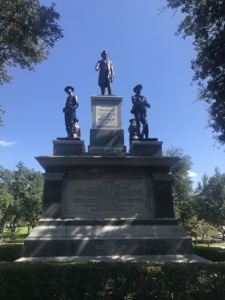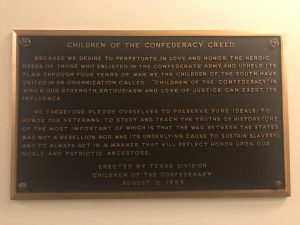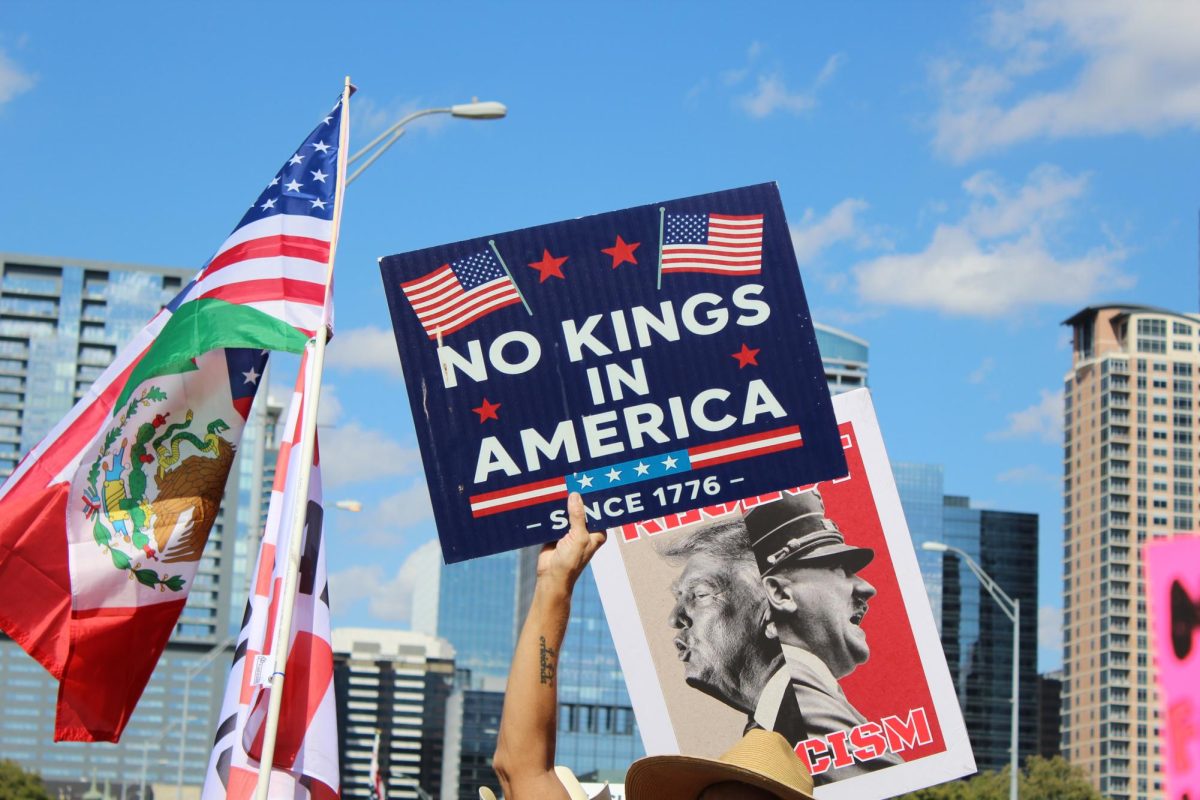
On the front lawn of the Texas Capitol, on the base of a statue erected in 1903, there is a plaque that reads “Died for State Rights guaranteed under the Constitution.” This statue, built to honor those who died fighting for the Confederacy, remains relatively unknown to the public. Even though the debate over the removal of Confederate monuments has become a polarized issue in the South and in America as a whole, it is easy to forget how close to home this controversy truly is.
To understand how these Confederate statues remain so prevalent in Texas, it is necessary to understand how the idea of Southern pride connects to our Confederate past. For many, Southern pride isn’t representative of fondness for life before the Civil War, but rather the connections people have to each other and their family.
Senior J.B. Faught is a third generation student at McCallum.
“When I think of Southern heritage,” Faught said, “I think of roots, like family. Heritage to me does not mean carrying down certain political views, or religion even. I think heritage to me has to do with where you came from, who your family was. That’s what heritage is.”
The idea of heritage comes up often when describing Southern pride, but the history of that heritage has different meanings to different people. McCallum librarian Jane Farmer grew up in a small town in East Texas, where Southern pride was a staple of everyday life.
“I grew up with that,” she said, “So I think it means different things to different people. For a lot of people, the South represented a chivalrous way of life, I think people picked out the good things about that. There was a pretty high moral code–people were friendly and kind to each other, that’s one side of it. And the other side is that the whole economy of the pre-Civil War South was based on treating people like things, and that’s obviously totally wrong. Recognizing that it was there, that’s just part of history. I’m glad that the conversation is going on. I think it should have happened a lot sooner.”
It is important to understand the historical origin of Southern pride. According to U.S. History teacher Joseph Carcione, the morals and ideals of the South date as far back as the American Revolution.
“It goes back to Madison and Jefferson, that they were the aristocracy of England, and that they were holding on to this more civilized gentile culture.” he said.
In the eyes of junior Joilyn Green, celebrating Southern heritage means recognizing where these ideals of the South come from.
“There’s two different southern heritages,” Green said. “There’s a white southern heritage, and there’s a black southern heritage. I think the white southern heritage takes all the good things from the past, and condenses it into something that’s easy to take, easy to swallow. I think black southern heritage is more of like, yes, terrible things happened to our family, but we’re still here, and we’re still prospering despite everything. It’s fantastic to take pride in your culture and your southerness, but don’t take pride without forgetting the history or forgetting how we got here and how this country was developed.”
Interpretation of the past is an important factor in the decision to take down Confederate monuments. To understand the reasoning behind the removal of these monuments, it’s necessary to understand when and why they were built in the first place.
According to Carcione, a majority of the monuments were erected in two periods of American history.

“Most of them were first erected when the older Confederate veterans were dying in the late 1800s, early 1900s,” he said, “In some places they were putting these statues up, especially the Daughters of the Confederacy, or their wives were putting monuments up to honor their service in the Confederate army. They also went up in in the 1940s and 50s to intimidate African Americans for pushing for civil rights. Some of it was done genuinely to honor people who were dying; some of them were done during the civil rights movement for intimidation.”
Even during the immediate aftermath of the Civil War, there was reluctance by some in the South to erect these monuments.
“Robert E. Lee had discussed not putting up monuments,” Carcione said. “Lee didn’t like the idea that they were celebrating the Lost Cause. He said the country should move past the war, he swore allegiance back to the Union, and he really saw it as something divisive. So Lee, ironically, didn’t want the monuments to go up.”
There have always been efforts to remove Confederate monuments, but it wasn’t until recent events that actions towards removal have been more frequent and successful. With the issue of racism being brought to the forefront of American politics and addressed more often on a national scale, many local governments and schools have taken action to remove Confederate monuments before controversy and conflict could expand to their backyards.
In 2016, the AISD school board voted to rename Robert E. Lee Elementary to Russell Lee Elementary. The decision was in direct response to the 2015 deadly shooting of African Americans in a church in Charleston, South Carolina, which spurred Americans to analyze the reasons behind dedicating government property to prominent members of the Confederacy.
To Faught, the issue is subjective.
“I think it’s kind of unnecessary,” he said. “Personally I don’t see a problem with the elementary school being named that. I know it’s controversial, but Robert E. Lee was kind of a mastermind war general, you know? He was a smart guy, but again, he could be seen as offensive or racist, so I understand where people are coming from, but to me the name change is not necessary.”
For others, like Green, the issue is much more relevant in the fight toward equality.
“I think it’s a good idea for them to rename the elementary school,” she said. “I feel like it is common sense, and I feel like they did really want to go through with it after tension in the past couple of months.”
After the events in Charlottesville, Va., in which in August a man plowed his car into a crowd of counter protesters responding to the demonstrations of white supremacists and Nazis, Gregory Fenves, the president of the University of Texas, had four statues removed from the south mall of the UT campus. These statues, honoring Confederate generals Robert E. Lee and Albert Sidney Johnston, Confederate Postmaster John H. Reagan, and Texas governor James Stephen Hogg, were relocated under the cover of darkness to ensure no clashes with protesters opposed to their removal.

This is not the first time UT officials have removed Confederate statues from the campus. In August 2015, Fenves also ordered the removal of statues of Jefferson Davis and Woodrow Wilson after the shooting in Charleston.
J.B. Bird, the director of Media Relations at UT, was able to provide insight on the reasoning behind the 2017 decision.
“In August, following the horrific displays of hatred in Charlottesville,” the president revisited the idea of relocating the remaining statues,” Bird said. “After receiving input from many members of the UT community, he decided that was the right thing to do at a time when white supremacists across the country are using Confederate statues as symbols of hatred and bigotry.”
According to Bird, the decision to take down the statues largely had to do with input from UT students.
“When people read about the question of removing Confederate monuments in Baltimore, Charleston, Austin, or other cities,” he said, “they often think about the national context, national political issues, and sometimes their own philosophical ideas as to whether the monuments should be removed. But for every statue, there are also highly local issues related to the people who live, work and see the statue on a daily basis. The decisions that community members reach are of course influenced by national discussions, but they are in the end very local decisions, rooted in the particular history of individual statutes and their relationships to the people around them.”
Because this is a local issue, it is personal to Southerners who have grown up around these monuments. Even with their removal, it is important to recognize this moment as an opportunity to reexamine how Southerners and America as a whole will interpret and remember our Confederate past.
“I think our history needs to be recognized so that we learn from the past,” Faught said, “that’s what history’s for, right?”







